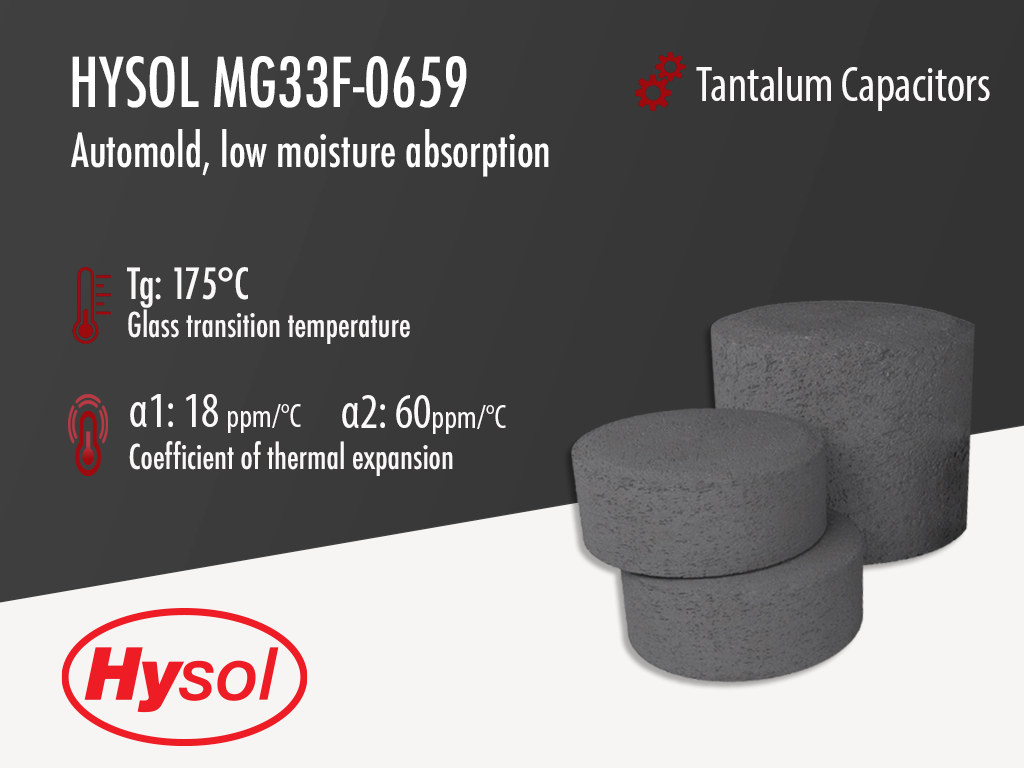Hysol MG33F-0659 | Black Epoxy Mold Compound
- Automold Tantalum capacitors
- Low moisture absorption
- High moldability and fast cycle time
Product Description
Hysol MG33F-0659 is a black, semiconductor-grade epoxy molding compound (duroplast) designed for the encapsulation and protection of tantalum capacitors and surface mount resistors. Because of its fast cure, it is also very well suited for the manufacture of reed relays.
Hysol MG33F-0659 has a filler weight of 75% and is formulated with a short gel time to make it useful for the production of (Ta) Tantalum capacitors through automolding processes. It is an environmentally friendly "green" molding compound which contains no bromine, antimony or phosphorus flame retardant and meets UL 94 V-0 Flammability at 6.35mm thickness.
Typical applications:
- Tantalum capacitors
- Reed relays
- Aluminum housed resistors (Check why MG33F-0659 is suitable for this application)
Features:
- Fast cured formulation (Check the curing conditions)
- Long spiral flow to provide best moldability and wide molding latitude
- Great adhesion to copper substrates and CTE matched with Al
- High thermal stability (High Tg and low stress )
- Low mold shrinkage (0.16%) for large components molding
Technical Specifications
| General Properties | |||||||||||
| Color Color The color | Black | ||||||||||
| Filler Content | 76 % | ||||||||||
| Specific Gravity Specific Gravity Specific gravity (SG) is the ratio of the density of a substance to the density of a reference substance; equivalently, it is the ratio of the mass of a substance to the mass of a reference substance for the same given volume. For liquids, the reference substance is almost always water (1), while for gases, it is air (1.18) at room temperature. Specific gravity is unitless. | 1.83 | ||||||||||
| |||||||||||
| Physical Properties | |||||||||||
| Spiral Flow @ 175°C | 66.04 cm | ||||||||||
| Chemical Properties | |||||||||||
| Moisture absorption | 0.45 % | ||||||||||
| Mechanical Properties | |||||||||||
| |||||||||||
| |||||||||||
| |||||||||||
| Electrical Properties | |||||||||||
| Volume Resistivity Volume Resistivity Volume resistivity, also called volume resistance, bulk resistance or bulk resistivity is a thickness dependent measurement of the resistivity of a material perpendicular to the plane of the surface. | 3.0x1015 Ohms⋅cm | ||||||||||
| Thermal Properties | |||||||||||
| |||||||||||
| |||||||||||
| Glass Transition Temperature (Tg) Glass Transition Temperature (Tg) The glass transition temperature for organic adhesives is a temperature region where the polymers change from glassy and brittle to soft and rubbery. Increasing the temperature further continues the softening process as the viscosity drops too. Temperatures between the glass transition temperature and below the decomposition point of the adhesive are the best region for bonding. The glass-transition temperature Tg of a material characterizes the range of temperatures over which this glass transition occurs. | 175 °C | ||||||||||
| UL 94 Rating UL 94 Rating Flammability rating classification. It determines how fast a material burns or extinguishes once it is ignited. HB: slow burning on a horizontal specimen; burning rate less than 76 mm/min for thickness less than 3 mm or burning stops before 100 mm V-2: burning stops within 30 seconds on a vertical specimen; drips of flaming particles are allowed. V-1: burning stops within 30 seconds on a vertical specimen; drips of particles allowed as long as they are not inflamed. V-0: burning stops within 10 seconds on a vertical specimen; drips of particles allowed as long as they are not inflamed. 5VB: burning stops within 60 seconds on a vertical specimen; no drips allowed; plaque specimens may develop a hole. 5VA: burning stops within 60 seconds on a vertical specimen; no drips allowed; plaque specimens may not develop a hole | V0 | ||||||||||
| Curing Conditions | |||||||||||
| |||||||||||
| |||||||||||
| Transfer Pressure | 40 - 85 kg/cm2 | ||||||||||
| Transfer Time | 6 - 15 s | ||||||||||
Additional Information
MG33F-0659 Epoxy Mold Compound for Aluminum Housed Resistors

Hysol MG33F-0659 is formulated based on MG33-0690, which is a industrial proven product for aluminum housed resistors encapsulation. They have pretty similar properties. You could check the properties comparison table below. Two extra advantages of MG33F-0659 are:
- (1) MG33F-0659 contains green flame retardants and meet UL90 V-0 flammability @1/4 inches, which MG33-0690 does not have.
- (2) MG33F-0659 has lower mold shrinkage than MG33-0690.
In conclusion, Hysol MG33F-0659 is a good alternative to MG33-0690 for aluminum housed resistor application.








